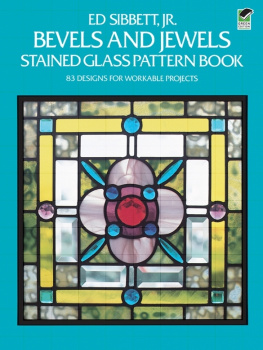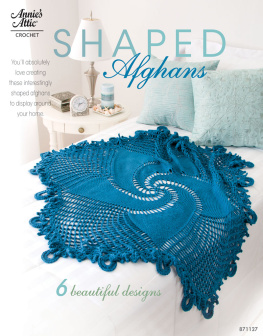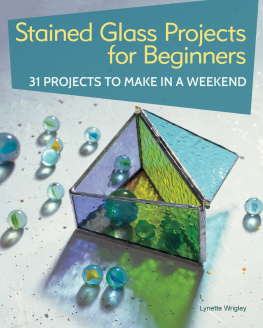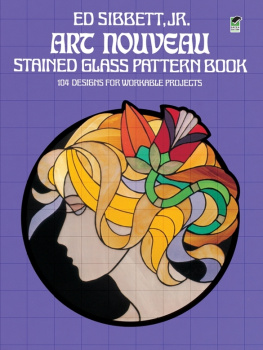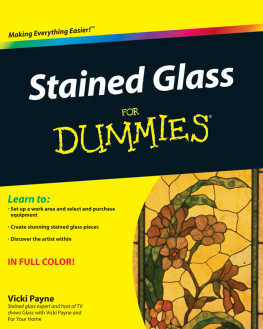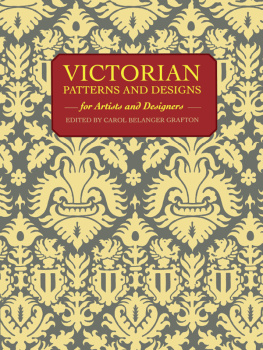
To my very tolerant family
Copyright 2013 by Stackpole Books
Published by
STACKPOLE BOOKS
5067 Ritter Road
Mechanicsburg, PA 17055
www.stackpolebooks.com
All rights reserved, including the right to reproduce this book or portions thereof in any form or by any means, electronic or mechanical, including photocopying, recording, or by any information storage and retrieval system, without permission in writing from the publisher. All inquiries should be addressed to Stackpole Books.
Printed in the United States of America
10 9 8 7 6 5 4 3 2 1
FIRST EDITION
Cover design by Wendy Reynolds
Library of Congress Cataloging-in-Publication Data
Mehaffey, Louise.
Decorative stained glass designs : 38 patterns for beautiful windows and doors / Louise Mehaffey. First edition.
pages cm
ISBN 978-0-8117-1144-9 (pbk.)
1. Glass painting and stainingPatterns. I. Title.
TT298.M423 2013
748.5028'2dc23
eBook ISBN 9780811749725
Introduction
I n this book youll find a compilation of thirty-eight original designs for stained glass windows that I created over a period of thirty years. This book is for those with experience in making stained glass windows, so I do not discuss the process. The designs are all original, developed and copyrighted by me. I provide the patterns for each panel, with photographs of my finished work and notes on making them. I started working with stained glass in the early 1970s. My family had moved into a house with a really ugly plastic sidelight by the front door, and I decided to make a stained glass window to replace it.
I started learning about this art, but before I could finish the window, we moved again. Nevertheless, I made the window and this experience was enough to hook me. I have been working with glass ever since. In 1998, I also started lampworking, and in recent years Ive been focusing on that small-scale glass craft, so now Ive decided to make my favorite stained glass designs available for other glass crafters to use.
My favorite part of working with stained glass was creating the designs. Over the years, I explored sandblasting and painting on glass, always incorporating that into my designs. Most of my business was making windows for homes, and it was always a challenge to create a design that satisfied both me and my client. Sometimes I was asked to do a commission that involved aspects with which I was not familiar, and I usually accepted those commissions. They forced me to learn new skills and led to some of my best designs. I also spent time every year creating designs just for me, and some of these designs led to working with more clients. I am not sure which I preferred, making a window for a client or making one just for me. They each had their limitations but also their freedoms. When making a window for a client, the design had to complement its location, and the style and subject were usually decided by the client. I found myself creating patterns I probably would not have designed otherwise, which was exciting, but I had to keep in mind what the client desired. When making a window for me, I was limited mainly by size, since I carried these around with me to exhibitions and shows, but I was free to create any design I wanted.
I used copper foil whenever feasible. This made the panels much lighter, which was important because of carrying them to shows. I could also cut and grind all the glass pieces of a design, put them in a box, and carry that around, so I could work on foiling the pieces whenever I had the chance. This was certainly not ideal, but I was able to get much more work done that way. Using copper foil also enabled me to achieve more detail than lead came would have, although some came enthusiasts may argue that point. I typically used a black-backed copper foil, because I often used a black patina on the solder lines, and the copper-colored back of the foil seen through the transparent glass would have detracted from the design.
Craftsmanship was very important to me, and I worked to make the solder lines smooth on both the front and back, so that they didnt distract from the design. Whenever I finished soldering a window, I cleaned it well, and then usually used a black patina on the solder. I felt that the bright silver solder lines distracted from the design, and using black patina made the design and the glass become the focus. It also eliminated that brand new element. When making autonomous panels, I used a strong zinc came for the outside edges, usually inch, and I used a special patina for zinc so that became dark also. Because many people move so often now, some clients didnt want the window installed. They planned on hanging it in front of the current window so that they could easily take it with them when they moved. For these panels, I also used a strong zinc came. For panels that were being installed, I used -inch H lead came, because the outer edge could be easily trimmed to fit the opening. As a final task, I waxed both sides with a carnuba wax, which helped repel fingerprints and dust.
This photo was the basis for the drawing on the next page. I liked the shape of the leaves, almost a pyramid with a burst of color at the top.
Learn about reinforcing your windows. Nothing is more discouraging than getting a phone call from a previous client telling you their window is sagging or buckling. Glass is very heavy and gravity is a strong force. It may take years, but if your windows are not properly reinforced, they will eventually sag, so learn to counteract it.
This drawing became the design for the window on . I illuminated most of the background, focusing on the leaves and blossoms.
I developed many patterns, with my inspiration coming mainly from the natural world. I loved the lines in nature that meandered and looked effortless. Those lines are far from effortless to create in glass, but I enjoyed the challenge. Occasionally, a client wanted a more traditional design, so I developed some of those too. It was always a thrill to finish a window and see it in place, with natural light illuminating it. I was always fascinated by how the window changed as the light changed and by the reflection of the colors into the room. Stained glass is so dynamic! After all my years of creating patterns, I decided it was time to share them. I hope you use them as inspiration to create your own designs.
I thank my clients, who allowed me into their homes and trusted me to create something special for them. They often pushed me to stretch my skills, which led to some wonderful designs. Thanks also to my editor, Kyle Weaver, and Stackpole Books for allowing me to share my designs.
Using the Patterns
For each design, I provide the dimensions for the original window I made, but you can adapt the design to the size you want. To use the patterns in this book, make copies of the designs, enlarging them to whatever size you need. An autonomous panel is easier than installation in an opening, because the size doesnt have to be exact. Simply solder hooks onto the frame and add a chain to hang it. To create a window to install, carefully measure the opening, enlarge the pattern to the largest measurement, and then decide where to trim the pattern to fit the smaller dimension. Another method of enlarging the design is to draw a grid on the pattern and then transfer the design to a larger grid. You can also simply sketch the design to the correct size.




